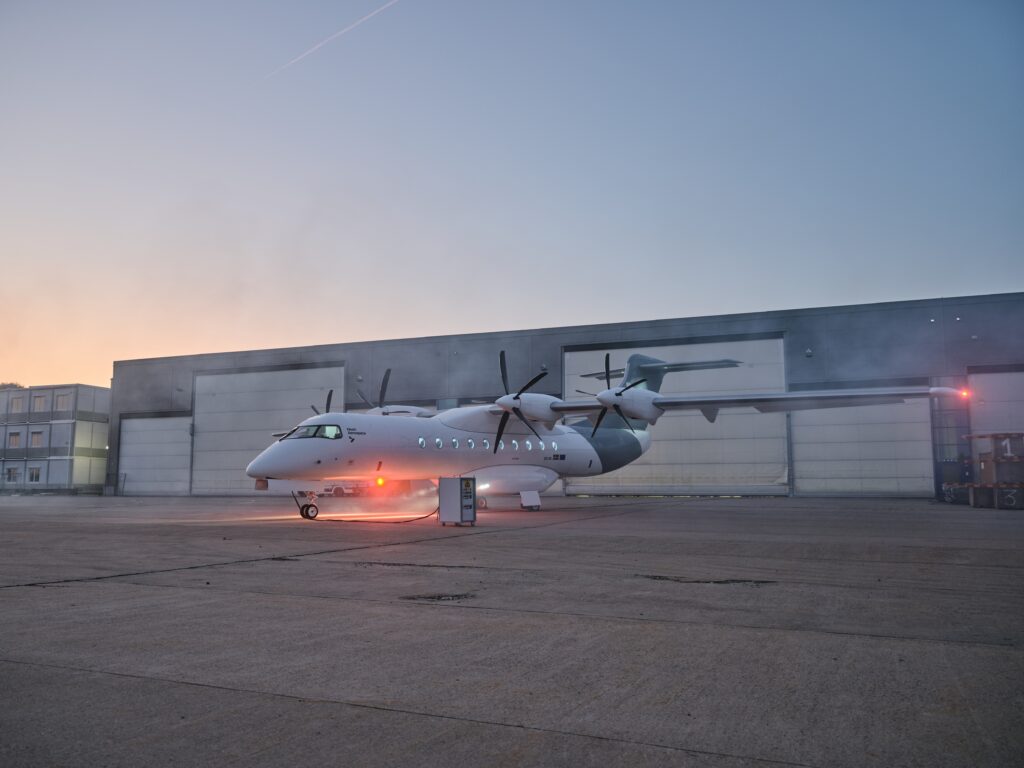Heart Aerospace Unveils Electric Aircraft Demonstrator: Potential Impacts on Regional Aviation and Passenger Experience
Share
Swedish startup Heart Aerospace today unveiled its first full-scale electric aircraft demonstrator, the Heart X1, marking a significant milestone in developing its ES-30 hybrid-electric regional aircraft. The unveiling took place at the company’s Hangar Day event in Gothenburg, Sweden, showcasing a 32-meter wingspan aircraft that serves as a precursor to the 30-seat ES-30, scheduled to enter service by the decade’s end.
The Heart X1, built almost entirely in-house in less than two years, demonstrates the company’s strategy of simultaneously developing both design and production processes.

Innovative technology and passenger experience
The ES-30 uses what Heart calls an “independent hybrid” system. Its rear fuselage features a large battery that powers two electric motors for takeoff and landing.
Two turboprop engines on the wings can be activated for longer flights or when additional power is needed. This design allows for all-electric flights up to 200 kilometres, extending the range to 400 kilometres in hybrid mode or 800km if the seats are reduced from 30 to 25. From an environmental perspective, Heart Aerospace claims that the ES-30 can reduce emissions by up to 50% even on longer 400-600 km flights compared to current turboprops.
Forslund highlighted the passenger experience aspects of the ES-30, saying that it can accommodate 30 passengers, each with up to 25 kilograms of luggage. Forslund noted that this capacity is comparable to current regional aircraft, suggesting that passengers may not need to compromise on comfort or luggage allowance when flying on this hybrid-electric plane.
As Heart Aerospace progresses with its development, several airlines, including SAS, Air Canada, and United Airlines, have placed orders for the ES-30.
Strategic Partnerships and Market Expansion

Two recent notable partnerships are with JSX and Loganair, the UK’s largest regional airline.
Last year, JSX signed a Letter of Intent (LOI) for up to 100 ES-30 aircraft from Heart Aerospace, comprising 50 orders and 50 options. Alex Wilcox, JSX CEO and co-founder, commented that the order “exemplifies our commitment to customer-friendly, carbon-reducing solutions that will offer the lower costs essential to providing vital air service to small communities across the country.”
At the Hangar Day, Simon Newitt, Heart’s President and Chief Commercial Officer, emphasised the significance of the JSX partnership: “The ES-30, with its competitive economics and green credentials, fits very well with JSX’s vision, and we see not only the opportunity to reconnect many regional routes lost over the years, but also open many more new ones.”
This partnership is particularly important as it demonstrates the potential for electric aviation to not only replace existing routes but also to expand air service to underserved communities.
JSX operates point-to-point flights to 24 destinations in the US and sees the ES-30 as a means to expand its reach. The company states that while network airlines can serve around 480 airports in the United States, JSX has the potential to serve over 2,000, with aircraft like the ES-30. This expanded reach could potentially reshape the landscape of regional air travel in the US.
Across the Atlantic, Loganair has entered into an exclusive partnership with Heart Aerospace. This collaboration is notable given Loganair’s experience in operating some of the world’s shortest commercial routes in the Highlands and Islands of Scotland. In a speech recorded for the Hangar Day, Luke Farajallah, CEO of Loganair, drew parallels between the evolution of electric aviation and the automotive industry, suggesting that aviation might follow a similar path from hybrid to fully electric solutions.
Heart Aerospace’s progress has not gone unnoticed by regulatory bodies. The company was recently awarded a $4.1 million grant under the Federal Aviation Administration’s (FAA) Fuelling Aviation’s Sustainable Transition (FAST) program. This funding will support the development of a management system for Heart’s innovative hybrid propulsion system, specifically a first-of-its-kind control system called the Hybrid Propulsion Automated Control System (HPACS).
The grant-related work will be carried out in the U.S., building on Heart’s growing footprint in the country. The company recently opened an R&D hub in Los Angeles, signalling its commitment to expanding its presence in the American market and collaborating with U.S.-based aviation experts and regulators.
Heart Aerospace aims to have the ES-30 certified by the end of the decade. After this, the company hopes to progress to the point where it can eventually produce 100-seat aircraft serving major urban short-haul routes in North America and Europe.
As John Slattery, Heart’s Chairman, said, “These are small aircraft; they’re tributaries, but tributaries feed streams, and streams feed rivers.” The ES-30 and similar aircraft could indeed be the tributaries feeding into a broader transformation of the aviation industry.


